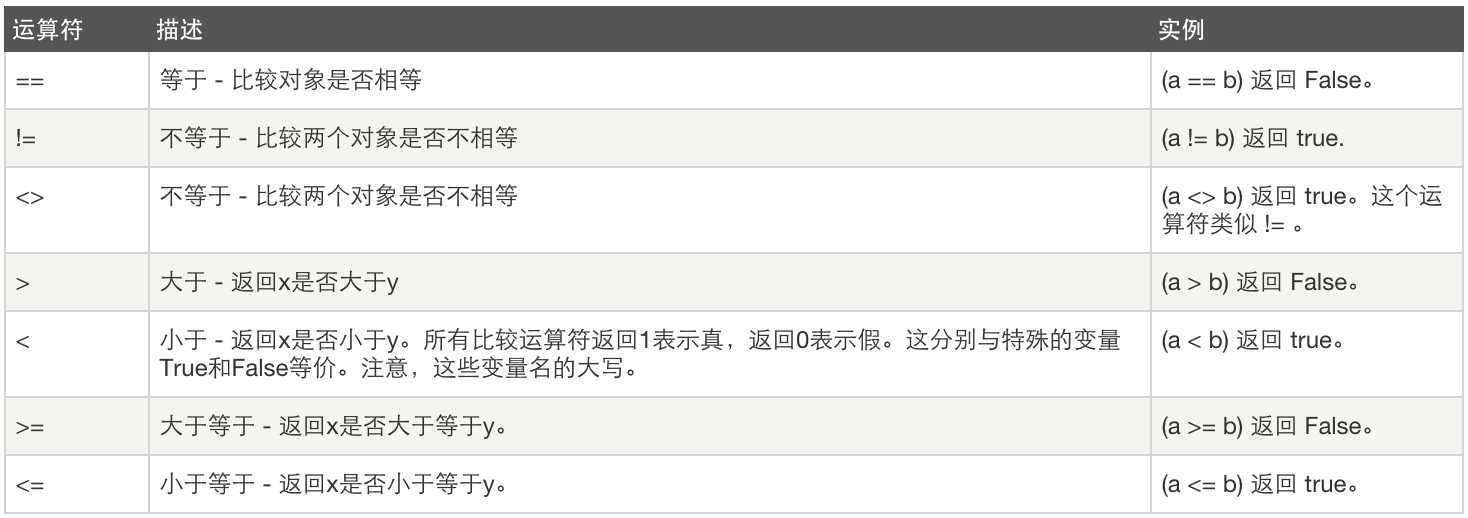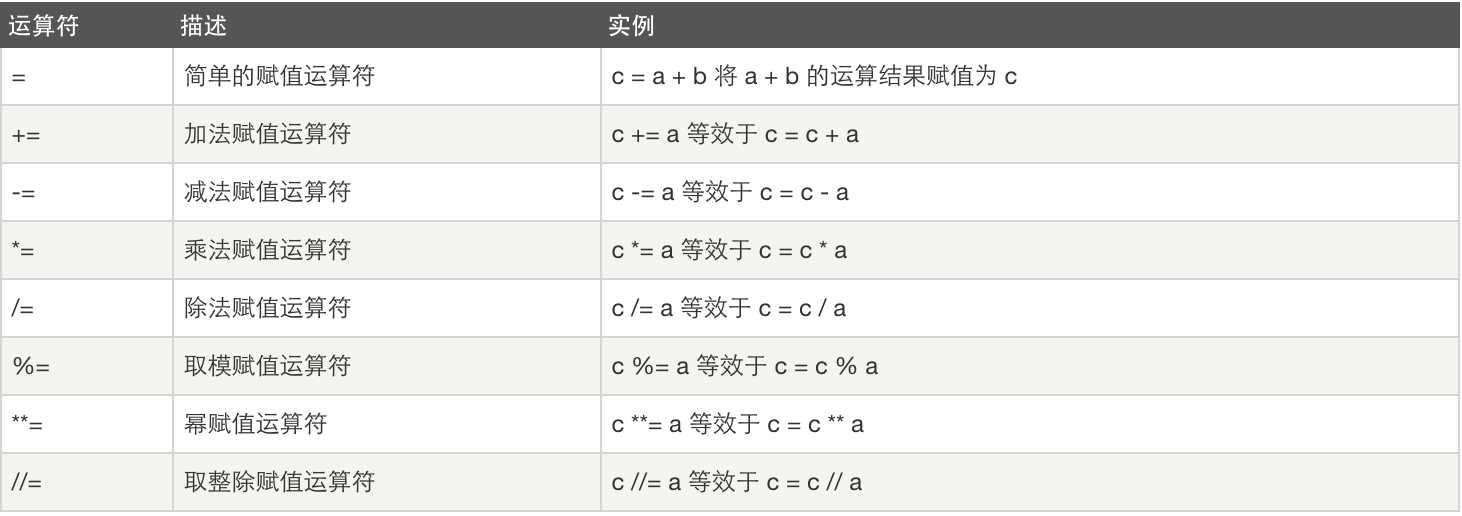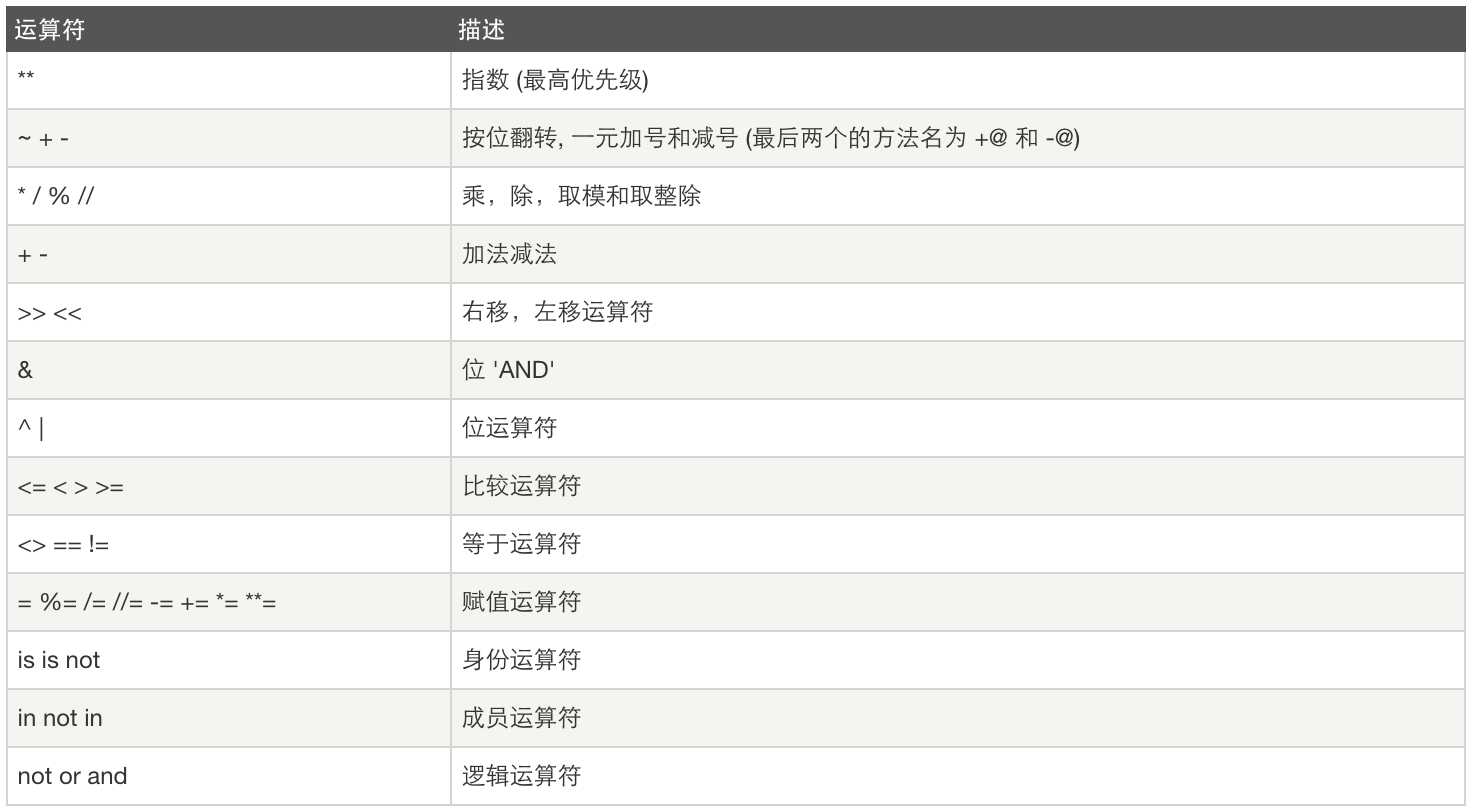标签:

Example:ArithmeticOperator.py
#!/bin/env python
# -*- coding:utf-8 -*-
__author__ = ‘Stephen‘
# set the initial value of a and b
print("%s%s%s" % ("="*4, "start", "="*4))
a = 3
b = 2
print("a=%s" % a)
print("b=%s" % b)
# start calculate
print("%s%s%s" % ("="*4, "calculate", "="*4))
# a+b
print("a+b=%s" % (a+b))
# a-b
print("a-b=%s" % (a-b))
# a*b
print("a*b=%s" % (a*b))
# a/b
print("a/b=%s" % (a/b))
# a%b
print("a%%b=%s" % (a % b))
# a**b
print("a**b=%s" % (a**b))
# end of the test
print("%s%s%s" % ("="*4, "end", "="*4))
运行结果:
====start==== a=3 b=2 ====calculate==== a+b=5 a-b=1 a*b=6 a/b=1 a%b=1 a**b=9 ====end====

Example:ComparisonOperator.py
#!/bin/env python
# -*- coding:utf-8 -*-
__author__ = ‘Stephen‘
def num_compare(a, b):
print("%s%s%s" % ("="*4, "start", "="*4))
print("a=%s" % a)
print("b=%s" % b)
# start compare
print("%s%s%s" % ("="*10, "compare", "="*10))
# if a=b ?
if a == b:
# print(u"a等于b")
print("a is equal to b")
else:
# print(u"a不等于b")
print("a is NOT equal to b")
# if a!=b ?, Type 1
if a != b:
# print(u"a不等于b")
print("a is NOT equal to b")
else:
# print(u"a等于b")
print("a is equal to b")
# if a!=b ?, Type 2 --> (deprecated)
# 这种写法即将被废弃
if a <> b:
# print(u"a不等于b")
print("a is NOT equal to b")
else:
# print(u"a等于b")
print("a is equal to b")
# if a<b ?
if a < b:
# print(u"a小于b")
print("a smaller than b")
else:
# print(u"a不小于b")
print("a is NOT smaller than b")
# if a>b ?
if a > b:
# print(u"a大于b")
print("a is larger than b")
else:
# print(u"a不大于b")
print("a is NOT larger than b")
print("%s%s%s" % ("="*20, "end", "="*20))
# Round 1
num_compare(3, 2)
# Round 2
num_compare(2, 3)
# Round 3
num_compare(2, 2)
运行结果
====start==== a=3 b=2 ==========compare========== a is NOT equal to b a is NOT equal to b a is NOT equal to b a is NOT smaller than b a is larger than b ====================end==================== ====start==== a=2 b=3 ==========compare========== a is NOT equal to b a is NOT equal to b a is NOT equal to b a smaller than b a is NOT larger than b ====================end==================== ====start==== a=2 b=2 ==========compare========== a is equal to b a is equal to b a is equal to b a is NOT smaller than b a is NOT larger than b ====================end====================

Example:AssignmentOperator.py
#!/bin/env python
# -*- coding:utf-8 -*-
__author__ = ‘Stephen‘
def set_initial_value():
# set the initial value of the numbers.
print("%s%s%s" % ("="*4, "initial value start", "="*4))
global a
global b
global c1
global c2
a = 3
b = 2
c1 = 10
c2 = 10
print("a=%s" % a)
print("b=%s" % b)
print("c1=%s" % c1)
print("c2=%s" % c2)
# print("%s%s%s" % ("="*4, "initial value end", "="*4))
# Assignment Operator Test
# 简单赋值运算
set_initial_value()
c1 = a + b
print("c1 = a + b ====> %s" % c1)
# 加法运算符
set_initial_value()
c1 += a
c2 = c2 +a
print("c1 += a ====> %s" % c1)
print("c2 = c2 +a ====> %s" % c2)
# 减法运算符
set_initial_value()
c1 -= a
c2 = c2 -a
print("c1 -= a ====> %s" % c1)
print("c2 = c2 -a ====> %s" % c2)
# 乘法运算符
set_initial_value()
c1 *= a
c2 = c2 * a
print("c1 *= a ====> %s" % c1)
print("c2 = c2 * a ====> %s" % c2)
# 除法运算符
set_initial_value()
c1 /= a
c2 = c2 / a
print("c1 /= a ====> %s" % c1)
print("c2 = c2 / a ====> %s" % c2)
# 取模运算符
set_initial_value()
c1 %= a
c2 = c2 % a
print("c1 %%= a ====> %s" % c1)
print("c2 = c2 %% a ====> %s" % c2)
# 幂赋值运算符
set_initial_value()
c1 **= a
c2 = c2 ** a
print("c1 **= a ====> %s" % c1)
print("c2 = c2 ** a ====> %s" % c2)
# 取整除运算符
set_initial_value()
c1 //= a
c2 = c2 // a
print("c1 //= a ====> %s" % c1)
print("c2 = c2 // a ====> %s" % c2)
运行结果:
====initial value start==== a=3 b=2 c1=10 c2=10 c1 = a + b ====> 5 ====initial value start==== a=3 b=2 c1=10 c2=10 c1 += a ====> 13 c2 = c2 +a ====> 13 ====initial value start==== a=3 b=2 c1=10 c2=10 c1 -= a ====> 7 c2 = c2 -a ====> 7 ====initial value start==== a=3 b=2 c1=10 c2=10 c1 *= a ====> 30 c2 = c2 * a ====> 30 ====initial value start==== a=3 b=2 c1=10 c2=10 c1 /= a ====> 3 c2 = c2 / a ====> 3 ====initial value start==== a=3 b=2 c1=10 c2=10 c1 %= a ====> 1 c2 = c2 % a ====> 1 ====initial value start==== a=3 b=2 c1=10 c2=10 c1 **= a ====> 1000 c2 = c2 ** a ====> 1000 ====initial value start==== a=3 b=2 c1=10 c2=10 c1 //= a ====> 3 c2 = c2 // a ====> 3

Example:LogicalOperator.py
#!/bin/env python
# -*- coding:utf-8 -*-
__author__ = ‘Stephen‘
# Definition
a = True
b = False
c = True
d = False
print("%s%s%s" % ("-"*10, "basic test start", "-"*10))
# test and operator
print("%s %s %s ====> %s" % (a, "and", b, a and b))
print("%s %s %s ====> %s" % (a, "and", c, a and c))
print("%s %s %s ====> %s" % (b, "and", c, b and c))
print("%s %s %s ====> %s" % (b, "and", d, b and d))
# test or operator
print("%s %s %s ====> %s" % (a, "or", b, a or b))
print("%s %s %s ====> %s" % (a, "or", c, a or c))
print("%s %s %s ====> %s" % (b, "or", c, b or c))
print("%s %s %s ====> %s" % (b, "or", d, b or d))
# test not operator
print("%s %s ====> %s" % ("not", a, not a))
print("%s %s ====> %s" % ("not", b, not b))
print("%s%s%s" % ("-"*10, "basic test end", "-"*10))
print("%s%s%s" % ("-"*10, "number test start", "-"*10))
# test number calculation
# 0 ==> False
# 非0 ==> True
w = 0
x = 2
y = -1
z = 0
#
print("%s %s %s ====> %s" % (x, "and", y, x and y))
print("%s %s %s ====> %s" % (x, "and", z, x and z))
print("%s %s %s ====> %s" % (x, "or", y, x or y))
print("%s %s %s ====> %s" % (x, "or", z, x or z))
print("%s %s %s ====> %s" % (w, "and", z, w and z))
print("%s %s %s ====> %s" % (w, "and", x, w and x))
print("%s %s %s ====> %s" % (w, "or", z, w or z))
print("%s%s%s" % ("-"*10, "number test end", "-"*10))
运行结果:
----------basic test start---------- True and False ====> False True and True ====> True False and True ====> False False and False ====> False True or False ====> True True or True ====> True False or True ====> True False or False ====> False not True ====> False not False ====> True ----------basic test end---------- ----------number test start---------- 2 and -1 ====> -1 2 and 0 ====> 0 2 or -1 ====> 2 2 or 0 ====> 2 0 and 0 ====> 0 0 and 2 ====> 0 0 or 0 ====> 0 ----------number test end----------

Example:MembershipOperator.py
#!/bin/env python
# -*-coding:utf-8-*-
__author__ = ‘Stephen‘
# Define a list.
test_list = [1, 2, 3, 4, 5, 6]
def test_in(item):
if item in test_list:
print("%s is a member of test_list %s" % (item, test_list))
else:
print("%s is NOT a member of test_list %s" % (item, test_list))
def test_not_in(item):
if item not in test_list:
print("%s is NOT a member of test_list %s" % (item, test_list))
else:
print("%s is a member of test_list %s" % (item, test_list))
# Test
print("%s%s%s" % ("-"*10, "in test", "-"*10))
test_in(4)
test_in(7)
print("%s%s%s" % ("-"*10, "not in test", "-"*10))
test_not_in(4)
test_not_in(7)
运行结果:
----------in test---------- 4 is a member of test_list [1, 2, 3, 4, 5, 6] 7 is NOT a member of test_list [1, 2, 3, 4, 5, 6] ----------not in test---------- 4 is a member of test_list [1, 2, 3, 4, 5, 6] 7 is NOT a member of test_list [1, 2, 3, 4, 5, 6]

Example:IdentityOperator.py
#!/bin/env python
# -*-coding:utf-8-*-
__author__ = ‘Stephen‘
print("%s%s%s" % ("-"*10, "number test", "-"*10))
x = 2
y = 2
z = 3
print("x = %s" % x)
print("y = %s" % y)
print("z = %s" % z)
if x is y:
print "x is y"
print("id(x) ====> %s" % id(x))
print("id(y) ====> %s" % id(y))
else:
print "x is NOT y"
print("id(x) ====> %s" % id(x))
print("id(y) ====> %s" % id(y))
if x is z:
print "x is z"
print("id(x) ====> %s" % id(x))
print("id(z) ====> %s" % id(z))
else:
print "x is NOT z"
print("id(x) ====> %s" % id(x))
print("id(z) ====> %s" % id(z))
print("%s%s%s" % ("-"*10, "string test", "-"*10))
a = "hello"
b = "hello"
c = "world"
print("a = %s" % a)
print("b = %s" % b)
print("c = %s" % c)
if a is b:
print "a is b"
print("id(a) ====> %s" % id(a))
print("id(b) ====> %s" % id(b))
else:
print "a is NOT b"
print("id(a) ====> %s" % id(a))
print("id(b) ====> %s" % id(b))
if a is c:
print "a is c"
print("id(a) ====> %s" % id(a))
print("id(c) ====> %s" % id(c))
else:
print "a is NOT c"
print("id(a) ====> %s" % id(a))
print("id(c) ====> %s" % id(c))
运行结果:
----------number test---------- x = 2 y = 2 z = 3 x is y id(x) ====> 5045844 id(y) ====> 5045844 x is NOT z id(x) ====> 5045844 id(z) ====> 5045832 ----------string test---------- a = hello b = hello c = world a is b id(a) ====> 36823552 id(b) ====> 36823552 a is NOT c id(a) ====> 36823552 id(c) ====> 36823616

Example:BitwiseOperator.py
#!/bin/env python
# -*- coding:utf-8 -*-
__author__ = ‘Stephen‘
# set the initial value of a and b
print("%s%s%s" % ("="*4, "start", "="*4))
a = 254 # 254 = 1111 1110
b = 192 # 192 = 1100 0000
c = 0
print("a=%s,binary:%s" % (a, bin(a)))
print("b=%s,binary:%s" % (b, bin(b)))
# Test
print("%s%s%s" % ("-"*20, "Test Start", "-"*20))
c = a & b
print("c = a & b ====> %s , binary: %s" % (c, bin(c)))
c = a | b
print("c = a | b ====> %s , binary: %s" % (c, bin(c)))
c = a ^ b
print("c = a ^ b ====> %s , binary: %s" % (c, bin(c)))
c = ~a
print("c = ~a ====> %s , binary: %s" % (c, bin(c)))
c = a << 2
print("c = a << 2 ====> %s , binary: %s" % (c, bin(c)))
c = a >> 2
print("c = a >> 2 ====> %s , binary: %s" % (c, bin(c)))
print("%s%s%s" % ("-"*20, "Test End", "-"*20))
运行结果:
====start==== a=254,binary:0b11111110 b=192,binary:0b11000000 --------------------Test Start-------------------- c = a & b ====> 192 , binary: 0b11000000 c = a | b ====> 254 , binary: 0b11111110 c = a ^ b ====> 62 , binary: 0b111110 c = ~a ====> -255 , binary: -0b11111111 c = a << 2 ====> 1016 , binary: 0b1111111000 c = a >> 2 ====> 63 , binary: 0b111111 --------------------Test End--------------------

Example: ArithmeticOperatorPriority.py
#!/bin/env python
# -*- coding:utf-8 -*-
__author__ = ‘Stephen‘
a = 12
b = 3
c = 4
d = 2
res = 0
res = (a + b) * c / d
print("(%d + %d) * %d / %d ====> %d" % (a, b, c, d, res))
e = ((a + b) * c) / d
print("((%d + %d) * %d) / %d ====> %d" % (a, b, c, d, res))
e = (a + b) * (c / d)
print("(%d + %d) * (%d / %d) ====> %d" % (a, b, c, d, res))
e = a + (b * c) / d
print("%d + (%d * %d) / %d ====> %d" % (a, b, c, d, res))
运行结果:
(12 + 3) * 4 / 2 ====> 30 ((12 + 3) * 4) / 2 ====> 30 (12 + 3) * (4 / 2) ====> 30 12 + (3 * 4) / 2 ====> 30
标签:
原文地址:http://www.cnblogs.com/thatsit/p/5828141.html